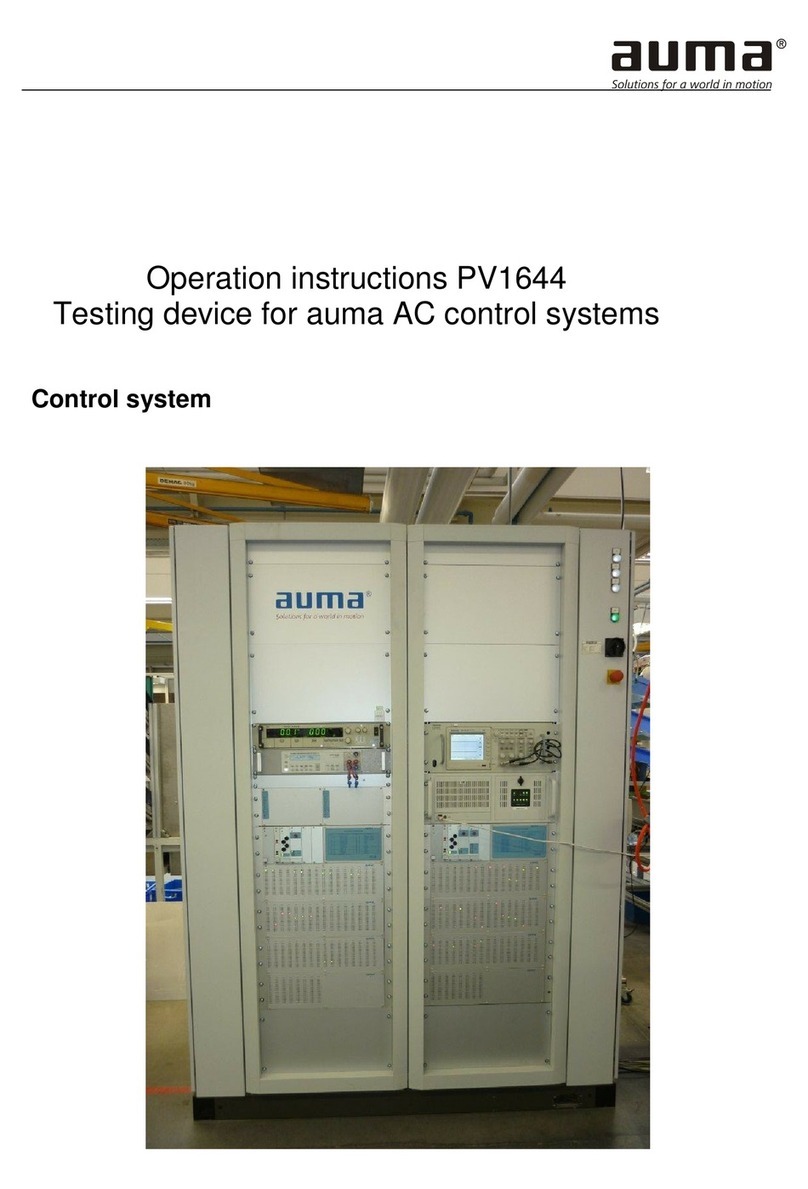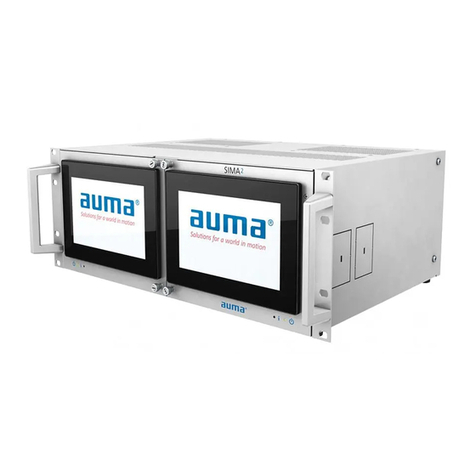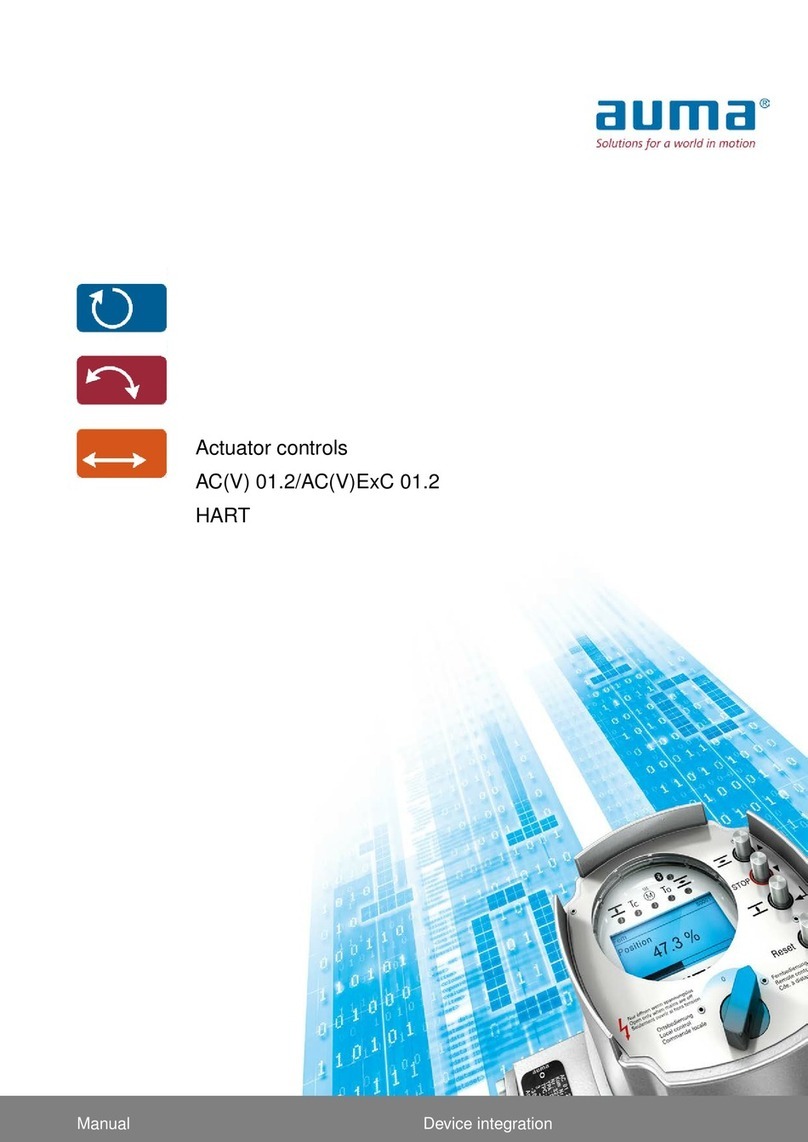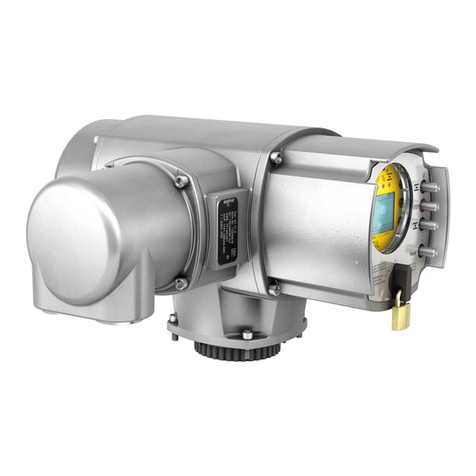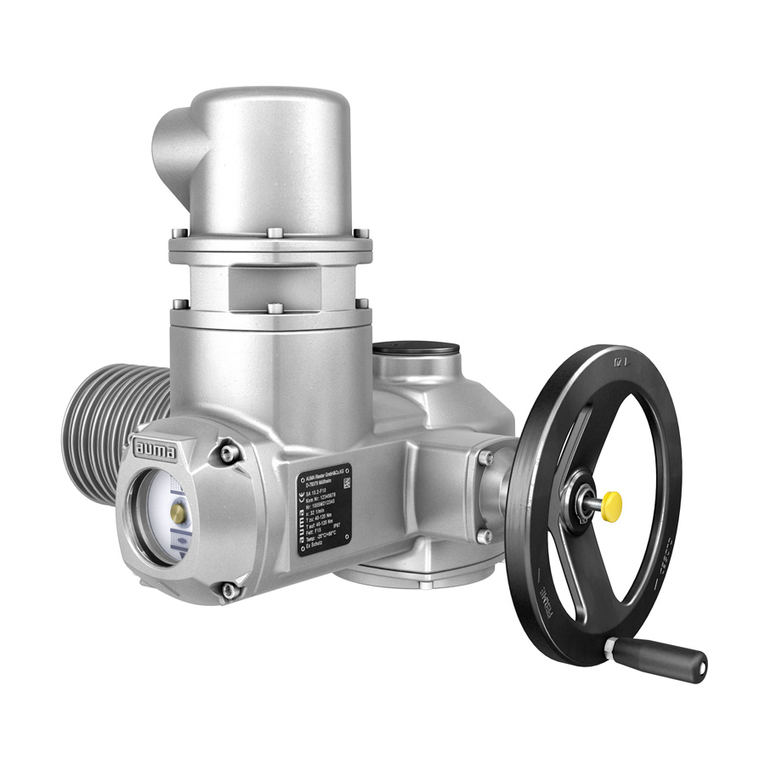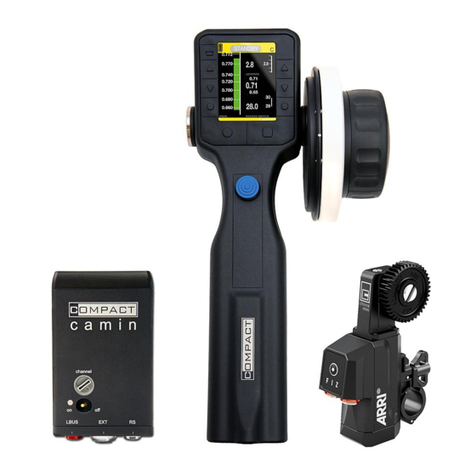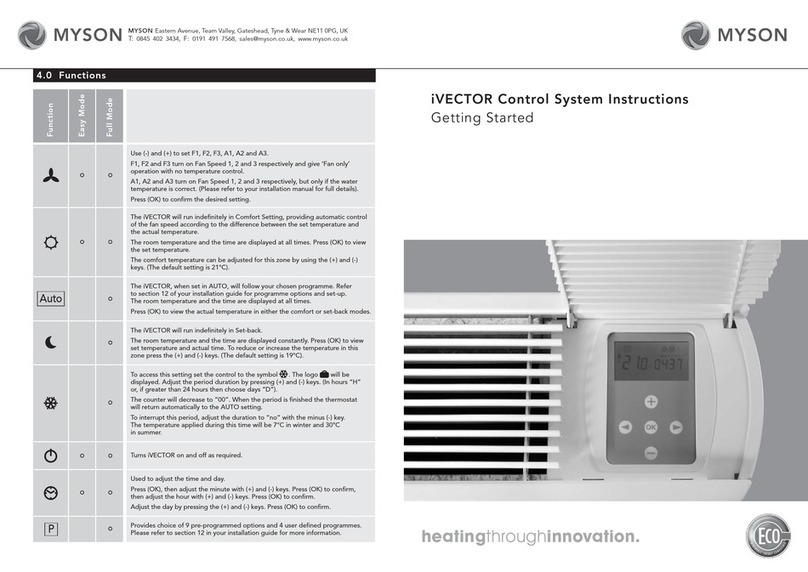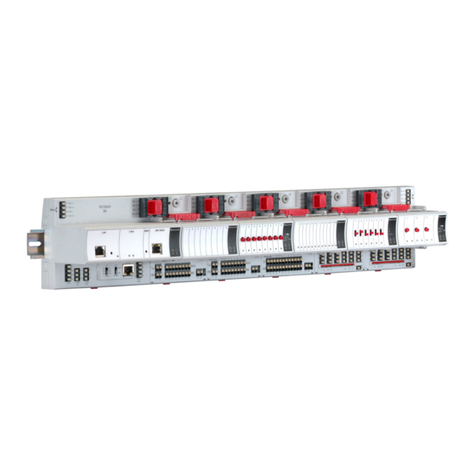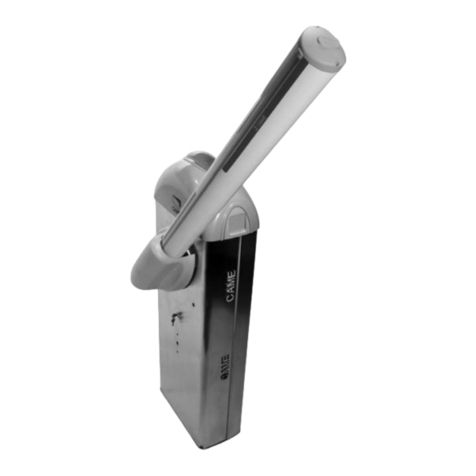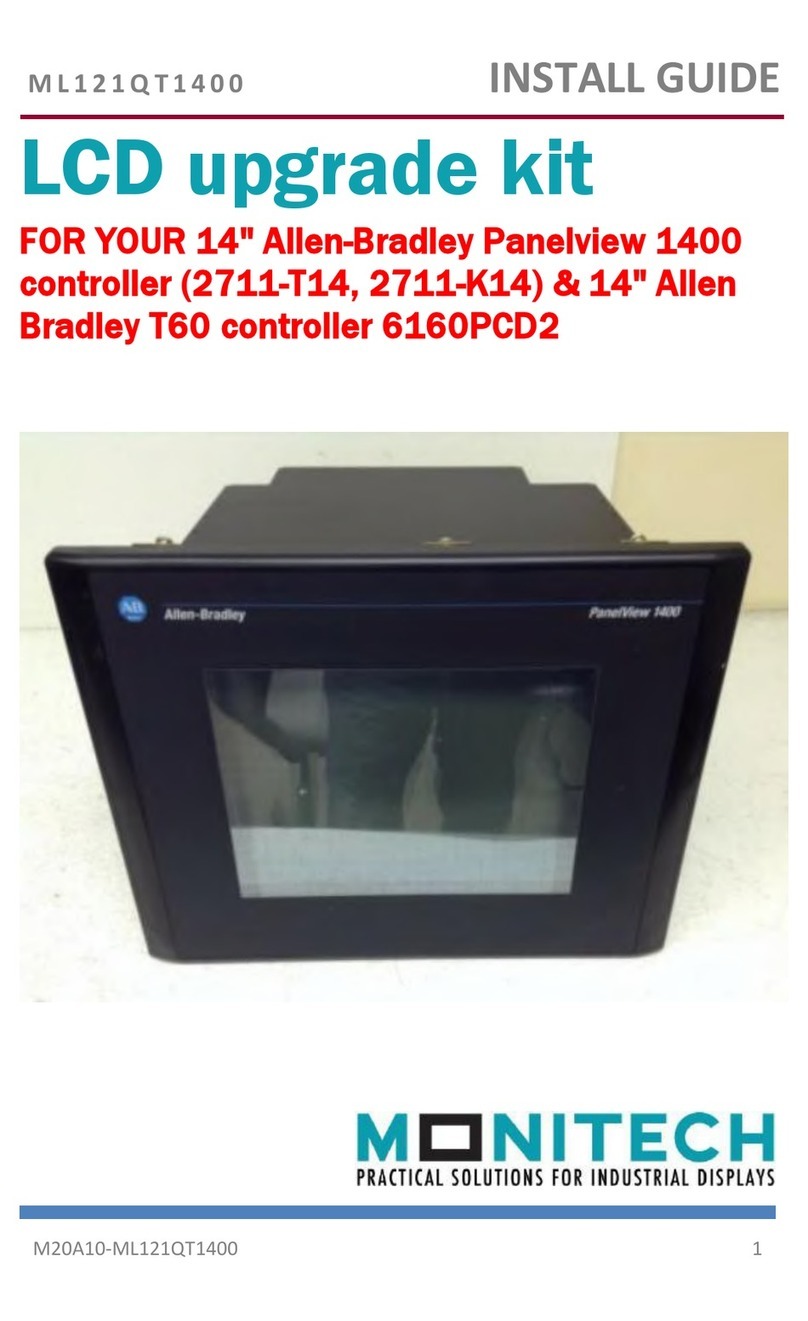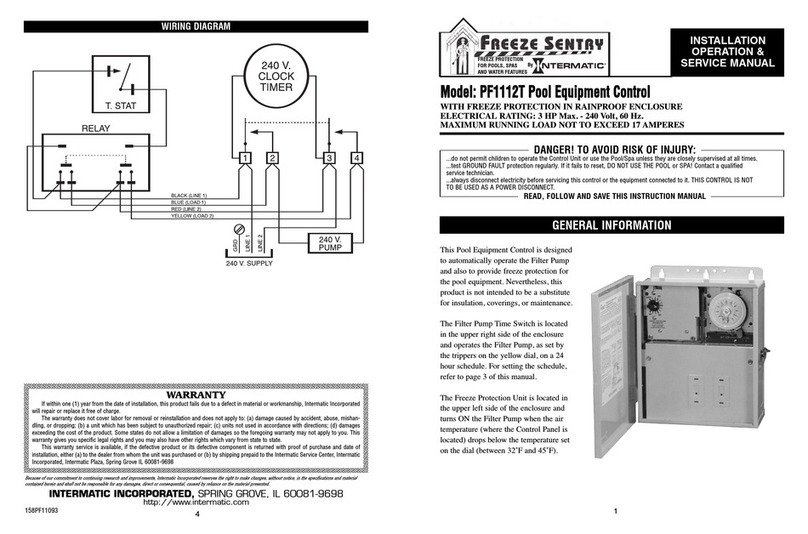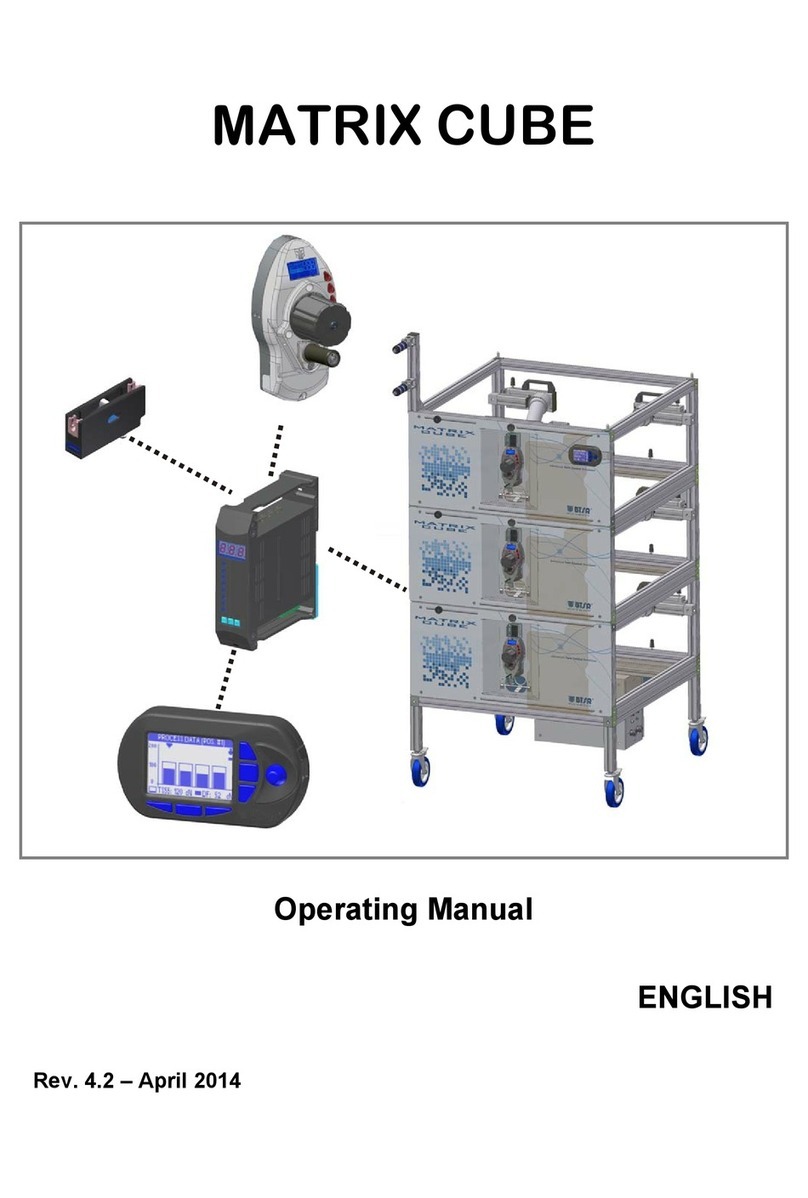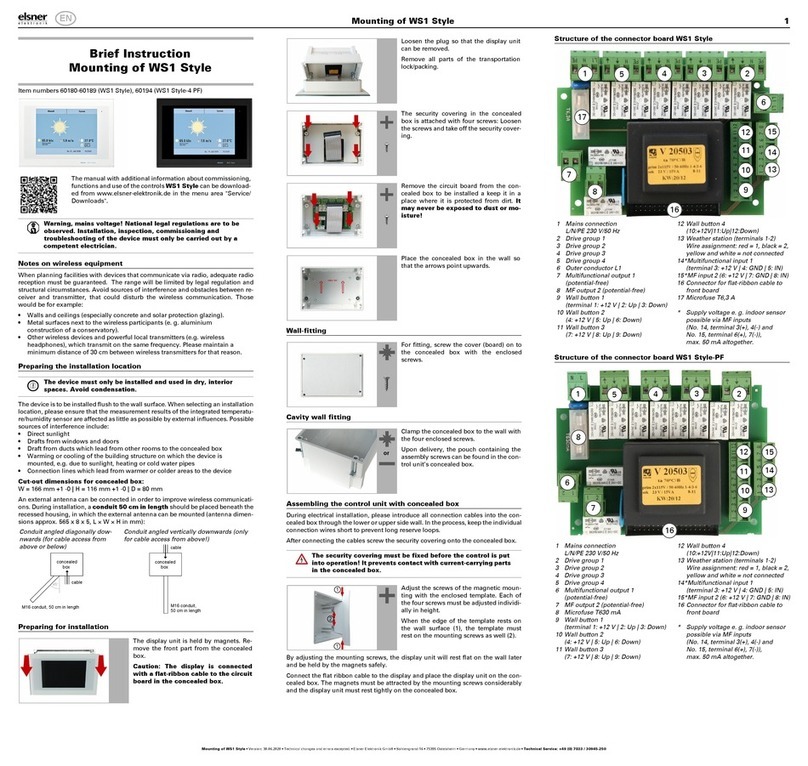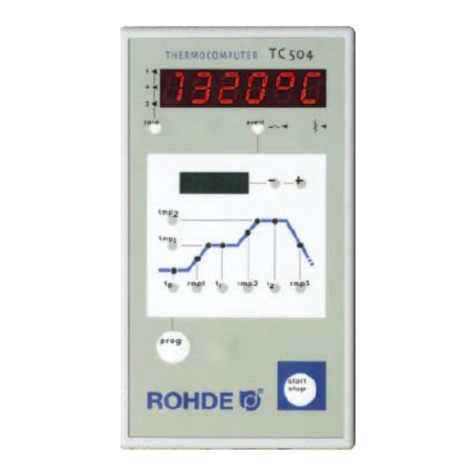AUMA EPAC Administrator Guide

1
EPAC
Operation Instruction Manual
VERSION: V3.XMP NON- INSTRUSIVE WITH
DATALOGGING (MWG)
(Weather Proof & Explosion Proof)

2
Table of Contents
1. SAFETY INSTRUCTIONS 3
BASIC INFORMATION ON SAFETY.......................................................................................................................31.1
STANDARDS/DIRECTIVES ......................................................................................................................................31.1.1
SAFETY INSTRUCTIONS/WARNINGS ........................................................................................................................31.1.2
QUALIFICATION OF STAFF .....................................................................................................................................41.1.3
COMMISSIONING ................................................................................................................................................41.1.4
OPERATION........................................................................................................................................................41.1.5
PROTECTIVE MEASURES........................................................................................................................................51.1.6
MAINTENANCE ...................................................................................................................................................51.1.7
RANGE OF APPLICATION .................................................................................................................................51.2
REFERENCES AND SYMBOLS .............................................................................................................................61.3
2. INTRODUCTION 7
2.1 LCD DISPLAY &LED INDICATION................................................................................................................7
2.2 INBUILT FRONT PANEL OPTION SELECTION ................................................................................................7
2.3 INTERFACES..............................................................................................................................................7
2.4 EMERGENCY STOP -ESD............................................................................................................................7
2.5 EVENT STORAGE &DATALOGGING OPTION ...............................................................................................8
2.6 PARTIAL VALVE STROKE TEST (PVST) OPTION............................................................................................. 8
2.7 INHIBIT OPTION........................................................................................................................................9
2.8 REMOTE SELECTOR SWITCH ......................................................................................................................9
2.9 LOCAL CONTROL STATION (LCS) PRIORITY..................................................................................................9
2.10 REMOTE LOCAL STOP..............................................................................................................................9
2.11 TIMER MODE..........................................................................................................................................9
2.12 PROGRAMMABLE RELAYS ..................................................................................................................... 10
2.13 REAL TIME CLOCK (RTC)......................................................................................................................... 10
2.14 POWER SUPPLY .................................................................................................................................... 11
2.15 SURGE PROTECTION AND LIGHTENING ARRESTER.................................................................................. 11
2.16 INBUILT POWER BACKUP DURING POWER OFF ...................................................................................... 11
3. FRONT PANEL DETAILS 12
SELECTOR SWITCH ...................................................................................................................................... 123.1
PUSH BUTTON SWITCHES ............................................................................................................................. 123.2
LCD SCREEN &LEDS .................................................................................................................................. 123.3
4. MODES OF OPERATION 14
PROGRAM MODE ................................................................................................................................... 144.1
EDIT/VIEW OPTION OF PROGRAM MODE .......................................................................................................144.1.1
CALIBRATION MODE............................................................................................................................... 234.2
LIMIT CALIBRATION ......................................................................................................................................254.2.1
DAC CALIBRATION ........................................................................................................................................264.2.2
4-20MACALIBRATION .....................................................................................................................................274.2.3
CHANGE TORQUE VALUE....................................................................................................................................294.2.4
PRESET TORQUE ...............................................................................................................................................304.2.5
DIAGNOSTIC MODE ................................................................................................................................ 354.3
5. TOPOLOGY CONNECTION 37
6. REGISTER DETAILS FOR MODBUS COMMUNICATION 40
7. TROUBLESHOOTING 43
8. EPAC NAMEPLATE 47
9. DISPOSAL AND RECYCLING 49
10. SERVICE 49

3
1. SAFETY INSTRUCTIONS
Basic information on safety1.1
Standards/Directives1.1.1
AUMA INDIA products are designed and manufactured in compliance with recognized
standards and directives. The list of certifications & agency of certification for Auma India products are
as given below..
All legal requirements, directives, guidelines, national regulations and recommendations with respect
to assembly, electrical connection, commissioning and operation are to be met by the end user or the
contractor at the place of installation. Customer has to follow specified standards for electrical
installations in explosion proof at& other hazardous areas. Modbus RTU application related
configuration guidelines are to be followed.
Safety Instructions/Warnings1.1.2
All personnel working with this device must be well-versed with the safety and warning
instructions in this manual and observe the instructions given. In order to avoid personal injury
or property damage, the safety instructions and warning signs must be observed carefully.
Kindly follow Common Electrical and Electronic related safety instructions according to
industrial standards. The main mechanical safety instructions are fixed on the actuators as

4
shown below.
Safety Instructions on Actuators:
Weather Proof and FlameProof/ExProof Safety instructions
FlameProof/ExProof Safety instructions
Qualification of staff1.1.3
Assembly, electrical connection, commissioning, operation, and maintenance must be
carried out exclusively by suitably qualified personnel having been authorized by the end
user or contractor of the plant only. Prior to working on this product, the staff must have
thoroughly read and understood these instructions and, furthermore, know and observe
officially recognized rules regarding occupational health and safety.
Work performed in potentially explosive atmospheres is subject to special regulations which
have to be observed. The end user or contractor of the plant is responsible for respect and
control of these regulations, standards, and laws.
Commissioning1.1.4
Prior to commissioning, it is important to check that all settings meet the requirements of the
application. Incorrect settings might present a danger to the application, e.g. cause damage
to the valve or the installation. The manufacturer will not be held liable for any consequential
damage. Such risk lies entirely with the user.
Operation1.1.5
Prerequisites for safe and smooth operation:
Correct transport, proper storage, mounting and installation, as well as careful

5
commissioning.
Only operate the device if it is in perfect condition while observing these instructions.
Immediately report any faults and damage and allow for corrective measures.
Observe recognized rules for occupational health and safety.
Observe the national regulations.
Protective measures1.1.6
The end user or the contractor is responsible for implementing required protective
measures on site, such as enclosures, barriers, or personal protective equipment for the staff.
Maintenance1.1.7
Auma India multi-turn actuators require very little maintenance but they
need to be tested regularly for its correct functioning. After commissioning, check
actuator for damage to paint finish. Do a thorough touch-up to prevent corrosion. Correct
commissioning is a prerequisite for reliable service. Seals made of elastomers are
subject to aging and must therefore regularly be checked and, if necessary, exchanged.
It is also very important that the O-rings at the covers are placed correctly and cable
glands fastened firmly to prevent ingress of dust or water.
We recommend additionally:
If operated seldom, perform a test run about every 6 months. This ensures that the
actuator is always ready to operate. The version of actuators discussed in this manual
have an option for Partial Valve Stroke Test (PVST) to check if the actuator is healthy.
Approximately six months after commissioning and then every year check bolts
between part-turn actuator and valve for tightness. If required, tighten applying
appropriate torques.
The gear housing is filled with lubricant in the factory. This filling lasts for several years
of service.
Corrosions of paint damage parts must be prevented through touch up.
Any device modification requires the consent of the manufacturer.
Range of application1.2
Auma India actuator controls are exclusively designed for the operation of Auma India
actuators. Other applications require explicit (written) confirmation by the manufacturer. The
following applications are not permitted.
Motor control

6
Pump control
No liability can be assumed for inappropriate or unintended use.
Observance of these operation instructions is considered as part of the device's designated use.
References and symbols1.3
The following references and symbols are used to provide information of the basic actuator
commands to the customer. They are:
Symbol for CLOSED (valve closed)
Symbol for OPEN (valve open)
Symbol for STOP (valve stop)

7
2. INTRODUCTION
AUMA INDIA has developed a new range of electric actuators with intelligent
integral starter using microcontrollers for weather proof and explosion proof applications
that has the ability to store events and other upgraded features. As a microcontroller is
used, the actuators support both ON-OFF and Regulating Duty Control. The actuator can
also be run in Inching or Non-Inching mode. The important features of these electric
actuators are as follows:
2.1 LCD DISPLAY & LED INDICATION
Options can be selected by using the selector switches, push buttons based on the
instructions displayed on the LCD screen. Information on faults/statuses can be obtained
from the 4 LEDs next to the LCD. The 4 LEDs are configurable as per user requirement
before-hand. LCD screen facilitates easier understanding of status, operation and
parameter setting details. More information regarding this is described in section 3.
2.2 INBUILT FRONT PANEL OPTION SELECTION
Different features/options of the actuator can be configured using software. This is
done using the selector switches, push buttons based on the instructions displayed on the
LCD screen that is present on the front panel. More information regarding this is described
in section 3.
2.3 INTERFACES
This actuator is capable of supporting different types of interfaces like Remote –4
Wire, Remote -2 Wire Make/Break, 4-20 mA Regulating Duty & MODBUS-RTU.
2.4 EMERGENCY STOP - ESD
ESD feature is default configured to run in Close direction on enabling ESD. One needs to enable
ESD and set its behavior in Program Mode for it to function. An ESD via MODBUS option is also
available that needs to be enabled in Program Mode. ESD Operation can be configured for
OPEN/CLOSE/STAY. One can choose to set ESD on TOLR Ignore, TH Ignore, Space heater Fail Ignore,
OFF Ignore. This means that ESD operation would occur irrespective of these faults. One must enable
ESD on program mode and set its behavior (ESD Open/Close). An ESD NO/NC configuration is also

8
available that can be configured in Program mode. ESD feature now can be carried out using an
external 24VDc supply also.
2.5 EVENT STORAGE & DATALOGGING OPTION
This range of actuators comes with an option to store events such as faults, statuses, number of
starts (Open in Local/Remote etc. using a Bluetooth module. The events are stored in a flash
memory and can be read via Bluetooth. The data logged will have a real time stamp and can be
downloaded using a user-friendly application called Auma India Utility Software onto a PC/
Laptop with Bluetooth connection. About 43691 events can be stored at a time using this
module. AIUS is also used in assisting commissioning and diagnosing the actuators. Device Tag is
customer configurable. Remote Operation of actuator through Bluetooth is also available.
The available events are as follows:
Number of Starts (Open and close in specified duration)
Open and close Command with Selector Switch Position
Tripping Torque Profile (Non-Intrusive)
Faults.
oLoss of Phase
o
o24 V Fail
oThermal Switch Trip.
oTorque Switch Trip
oControl Supply Failure
oTOLR
Selector Switch Change.
End Position
ESD
More details of this feature is available in AIUS User Manual ( Doc. No.: 4-AIUS-MANUAL-39396).
2.6 PARTIAL VALVE STROKE TEST (PVST) OPTION
This feature is used in checking correct functioning of valves which are not operated for a
long period. When PVST is triggered the valve moves to particular percentage and come
back to the same end position and gives PVST result. The features are:
PVST can be triggered externally through a switch or via MODBUS.
PVST command can be given through MODBUS using dedicated registers.
PVST Position can be configured in the following two ways.
From Open End
From Close End
PVST Percentage can be set to any of the three options.
5%, 10%, 15%

9
PVST Failure : This failure occurs when the PVST command doesn’t take place after a specified time
(that is specific to actuators based on its RPM and No. of Turns). This failure is indicated by using
any one of the programmable relays present in your module.
2.7 INHIBIT OPTION
Inhibit is an interlock for open close operations. Inhibit Operation can be Enabled or Disabled in
Software (Program Mode). In this module, separate terminals for Inhibit Open and Inhibit Close are
available. Based on this, Open/Close Commands can be inhibited.
2.8 REMOTE SELECTOR SWITCH
This option allows the user to create a selector switch for the actuator in Remote mode. It is mainly
used to lock/unlock the Local operation of the actuator using push buttons through a Remote
command. This is serves as a software lock.
2.9 LOCAL CONTROL STATION (LCS) PRIORITY
When this feature is enabled, the user can control the actuator in remote 4 –wire mode of operation
even when in 4-20mA or MODBUS mode of Operation.
2.10 REMOTE LOCAL STOP
This option is also software configurable and can be enabled in Program Mode. The actuator
should stop running in Remote Mode when STOP key is pressed in the Actuator Front Panel. No
commands should be accepted by the actuator until it is reset.
2.11 TIMER MODE
Timer mode is used to control the valve movement. This mode allows us to open or close the valve
slowly towards the end position after reaching a certain distance with continuous operation.
Configurable Options
Open timer start Valve Position: The user has to set the valve position at which this Timer
mode should go on for Open Command.
Open ON time : This parameter decides the amount of time (in s) the actuator runs in Open
direction before shutting off for Open OFF time (in s). This continues to happen until the
respective limit switch is hit (unless the switch is bypassed).
Open OFF time: This parameter decides the amount of time (in s) the actuator shuts off
before running in open direction for Open ON time (in s). This continues to happen until the
respective limit switch is hit (unless the switch is bypassed).

10
Close timer start Valve Position : The user has to set the valve position at which this Timer
mode should go on for Close command.
Close ON time : This parameter decides the amount of time (in s) the actuator runs in Close
direction before shutting off for Close OFF time (in s). This continues to happen until the
respective limit switch is hit (unless the switch is bypassed).
Close OFF time : This parameter decides the amount of time (in s) the actuator shuts off
before running in open direction for Open ON time (in s). This continues to happen until the
respective limit switch is hit (unless the switch is bypassed).
2.12 PROGRAMMABLE RELAYS
As per standard two relays are given for customer end information - Fault Relay & Optional Relay 1.
There are about 6-8 more additional relays that have been added along with this module. Each of
these relays can be configured for the following 27 faults/statues as given below.
List of available relays
o Fault Relay
o Optional Relay ( 3 relays)
o Additional Relay(2 Latching relays)
Available Programmable options are:
oOpened (Open Limit Trip)
oClosed (Close Limit Trip)
oRemote Local stop
oLocal Stop
oOpen Torque Trip
oClose Torque Trip
oLoss of Phase
oTH-Trip
oTOLR Trip
oControl Supply Fail
oPhase reversal
oJammed Valve
oPower ON
oProgram Mode Indication
oSP Reached ( via DAC/MODBUS)
oSelector SW LOCAL
oSelector SW OFF
oSelector SW REMOTE
oESD Pressed
o24V DC Fail
oSpace Heater Fail
oRunning Open
oRunning Close
oRemote Selector SW EN
oPVST Fail
oIntermediate Pos
o4-20mA Signal Fail
2.13 REAL TIME CLOCK (RTC)
This module has a Real time clock that is used to obtain the time-stamp for Event logging. The RTC
can be configured by Auma Utility Software or by manually setting the RTC in Program Mode
settings. The RTC is powered by a Super Capacitor when the power is off which is another added
feature of this module. The Super Capacitor takes about 2 hours to charge and can supply power

11
upto 20 days to the RTC.
2.14 POWER SUPPLY
The Power Supply Card used in this module has several new features. The features are as follows:
Under Voltage Protection
Over Voltage Protection
Short Circuit Protection
Uses Single Transformer with selectable voltage & frequency range
Voltage Range : 360VAC to 480VAC
Frequency Range: 47.5Hz to 63Hz.
2.15 SURGE PROTECTION AND LIGHTENING ARRESTER
This module has protection again voltage surges and lightening by using a protection card for 4-
20ma/ MODBUS operation. This card is called Surge protection and lightning arrester (SP & LA)
card. It is placed between command signal line and Interface (IF) card to eliminate the voltage
fluctuations. This card is given as default when Modbus or regulating duty is given.
NOTE: The features supported by your actuator is with respect to the wiring diagram (WDP)
provided with it. Please remember that it might not have all the features described in this
document.
2.16 INBUILT POWER BACKUP DURING POWER OFF
This module has an extra feature that it will provide a power backup for about 30 minutes when the
3-phase supply goes off. The display will be on and the Modbus communication feature will continue
to work during that time. Also, the handwheel operation is reflected on the display.

12
3. FRONT PANEL DETAILS
This section outlines the front panel details of 3.XMP Actuators. Fig. A shows the picture of
the same. The functions of each of these components are discussed below.
Fig. A: 3.XMP NON INTRUSIVE WITH BLUETOOTH FRONT PANEL
Selector Switch3.1
There are 3 modes available; LOCAL, OFF & REMOTE. The mode selection can be
done by using the selector switch.
Push Button Switches3.2
Actuators are made to run in OPEN or CLOSE direction by pressing the respective
push buttons and can be stopped in middle during travel by pressing STOP push button.
These three push buttons are also used for programming and calibrating the actuator.
LCD Screen & LEDS3.3
The basic LCD view is split into two lines. The first line shows the status details - The
left half shows selector switch position status and the actuator running status alternatively.
The right half of the first line represents Valve Position (VP) in terms of percentage. The
valve position display feature is optional. If required, an appropriate Electronic Position
Transmitter (EPT) must be chosen for this feature. Please contact AUMA India for more
information.
The second line is used to represent only faults. The faults/warnings if any toggle in
the sequence of occurrence. The details are as shown in the Fig. B.
Information regarding the running indication of the actuator (status) and faults are
indicated by the LEDs present on the left side of the LCD screen which is as shown in Fig. B.
LCD SCREEN
PUSH BUTTON SWITCHES
LED FOR STATUS INDICATION
SELECTOR SWITCH

13
Fig. B: 3.XMP NON INTRUSIVE WITH BLUETOOTH LED & LCD SCREEN
One can configure the four LEDS on the display module to represent different conditions. The default
LED settings are as below:
COLOR
INDICATION
MODE
GREEN
If LED is blinking then actuator is running in OPEN direction.
If LED is continuously ON then actuator is fully OPENED.
If LED is OFF –then actuator is in Mid-Travel.
AMBER
If LED is blinking then actuator is running in CLOSE direction.
If LED is continuously ON then actuator is fully CLOSED.
If LED is OFF –then actuator is in Mid-Travel.
RED
If LED is continuously ON -- Fault Condition
If LED is OFF –No fault Condition
WHITE/BLUE
Default: OFF
If LED ON: Paired and Connected with Auma India Utility
Software/ Whenever BT is connected
CURRENT VALVE POSITION
ACTUATOR RUNNING
STATUS
FAULT and STATUS LEDS
COMMUNICATION LED
FAULTS WILL BE DSIPLAYED
HERE

14
4. MODES OF OPERATION
This section describes about the modes available for selection in this module. The options are:
MODE 1 - Program mode
MODE 2 - Calibration mode
MODE 3 - Diagnostic mode
There are several options/settings that are available in each of these modes. These are discussed
below.
PROGRAM MODE4.1
The push buttons on the Front Panel can be used for programming. To enter into PROGRAM MODE,
follow the below steps:
Step 1: Keep the selector switch in OFF position
Step 2: Press Open + Close keys together for approximately 6 seconds.
Step 3: Press the STOP key on the display of “Program Mode” as shown in the below figure.
In the program mode, one can choose to configure settings as per custom requirements. The three
sub-categories are –General settings, Remote settings and Relay settings. The flowcharts to choose
EDIT/VIEW and any one subcategory are given below.
EDIT/VIEW option of PROGRAM MODE4.1.1
By entering the appropriate password, user can enter into the “PROGRAM MODE” for 3.XMP Non
Intrusive with Bluetooth Module as shown in the above flowchart. The features that can be set in this
are given in the below flowchart.

15
General Settings:4.1.1.1
Following options can be set by using the Open or Close keys in “GENERAL SETTINGS” of “PROGRAM
MODE” for 3.XMP Non-Intrusive with Bluetooth Module.
Program Mode
Stop Key Enter
Enter Password
Press Stop Key
Enter Password
****
General Setting
Stop Key Enter
A
Relay Setting
Stop Key Enter
B
Remote Setting
Stop Key Enter
C
Close
Close
Close
Open
Open
Open
Stop
Stop
Stop
Stop
Stop
Stop
Stop key to enter digit,
Press open or close key to increment or decrement
the digit value
Other Setting
Stop Key Enter
Close
Open
Open
1
Stop

16
E
Emergency Behave
Close
ESD NO/NC
NO
Stop
ESD Ignore TOLR
Enable
Stop
ESD Ignore TH
Disable
Stop
ESD Ignore SPH
Disable
Stop
ESD in OFF mode
Disable
Stop
ESD via MODBUS
Disable
Stop
H
PROGRAM MODE - General Settings Flowchart
H
I
MODE Select
REMOTE
SEL SW Select
REMOTE
Stop
Stop
Stop
Stop
Stop
Stop
Stop
F
Local Mode
Non-Inching
A
Timer Mode
Disable
Disable
Enable
Emergency Mode
Enable
Disable
Enable
Stop
Stop
Stop
BYPASS OLS
Disable
BYPASS CLS
Disable
INHIBIT
Disable
Remote Local Stop
Disable
Remote Sel sw
Disable
Enable
Disable
D
E

17
Remote Selector Switch Options:
Enabling Remote Selector Switch in program mode provides an option for the user to select
Local/Remote mode through Remote Operation. There are 4 wires available on the user end –(RM/L
SS+ & RM/LSS-) and (R/L M SS+ & R/L MSS-). Based on different NO/NC configurations of these wires
and the selection of MODE select & SEL Switch Select will give different options as shown in the
flowchart below.
Remote Settings:4.1.1.2
The sub options available in this category are shown below.
I. Selection of remote inching /non inching
II. 2-wire remote operation: One of the following option will be available with the
default/factory setting.
2-wire make/break
2-wire Modbus
2-wire 4-20mA
4-wire
4-wire negative switching
The flowchart for Remote settings is given below.
D
Open Starts
From VP: 80%
Open ON Time
5 Sec
Stop
Open OFF Time
5 Sec
Stop
Close Starts
From VP: 20%
Stop
Close ON Time
3 Sec
Stop
Close OFF Time
5 Sec
Stop
Stop
I
F
TOLR NO/NC
NO
Space Heater
Disable
FOUR-
WIRE
Valve Position
Enable
Stop
PVST
ENABLE
EVENT STORAGE
Disable
Stop
PVST Position
CLOSE
Enable
Stop
PVST PERCENTAGE
5%
Disable

18
PROGRAM MODE - Remote Settings Flowchart
C
Remote Mode
Non-Inching
Stop
Remote TWO-WIRE
MODBUS
Stop
TWO-WIRE
Negative Switching
Disable
Stop
FOUR-WIRE
Remote TWO-WIRE
4-20 MA REG
Remote TWO-WIRE
MODBUS
Remote TWO-WIRE
2-WIRE 24V
RM TWO-WIRE
BREAK/MAKE
Signal Fail
Stay
Select SSR
Y/N?YES
Open P-Band
005
Open CT
001
Open H-Band
0.5
Slave Address
ID:001
Baud Rate
9600
Parity
NONE
Repeater
OFF
Remote Setting
Stop Key Enter
YES
NO
Stop
Stop
Stop
Stop
Stop
Stop
Stop
Stop
Stop
Stop
Stop
Stop
Stop
Stop
Stop
Stop
Remote Mode Type
Two-Wire
Close H-Band
Enable
Close P-Band
0.5
Close CT
0.5
LCS Priority
Enable
Stop
Stop
Stop
Dead Band
0.5
Inertia
1.0

19
The working of each of the different remote operations is described in the 3.XMP Test Procedure Document: 4 -
V3.XMP-39305.
Relay Settings:4.1.1.3
There are two main relays available for setting different faults/ actuator status. These are Fault relay
and Optional Relay.
The default configurations for Fault relay are:
1. 24V supply fail Enable /Disable
2. Control supply fail Enable /Disable
3. Single phasing
4. Open Torque Trip
5. Close Torque Trip
6. Jammed Valve
7. Thermal Switch Trip
The default configurations for Optional relay are: TOLR Trip
There are about 25 features/ conditions available as shown below which the user can choose set for
either of the relays. Note that during the relay setting selection, one or multiple option can be selected
for the same relay.
1. Opened (Open Limit Trip)
2. Closed (Close Limit Trip)
3. Remote Local stop
4. Local Stop
5. Open Torque Trip
6. Close Torque Trip
7. Loss of Phase
8. TH-Trip
9. TOLR Trip
10. Control Supply Fail
11. Phase reversal
12. Jammed Valve
13. Power ON
14. Program Mode Indication
15. SP Reached ( via DAC/MODBUS)
16. Sel SW LOCAL
17. Sel SW OFF
18. Sel SW REMOTE
19. ESD Pressed
20. 24V DC Fail
21. Space Heater Fail
22. Running Open
23. Running Close
24. Remote Sel SW EN
25. PVST Fail
26. Intermediate Pos
27. 4-20mA Signal Fail
Note that the Additional Optional Relays and Additional Relays (Four Numbers) can be configured for the same
set of faults as shown in the flowchart below. The default settings are off for all of them. These can be
configured in Factory Settings in Diagnostic Mode that will be discussed in section 3.

20
C
Open->FLT Rly
Close->OPT Rly
Opt-Rly Opened
YES/NO?
Opt -Rly Closed
YES/NO?
Opt -Rly Remote Local Stop
YES/NO?
Opt -Rly Local Stop
YES/NO?
Opt -Rly Open torque trip
YES/NO?
Opt -Rly Close torque trip
YES/NO?
Opt -Rly Loss of Phase
YES/NO?
Opt -Rly TH- Trip
YES/NO?
Opt -Rly TOLR Trip
YES/NO?
Opt -Rly Cntrl spl fail
YES/NO?
Opt -Rly Phase Reversal
YES/NO?
Opt -Rly Jammed Valve
YES/NO?
K
F-Rly Opened
YES/NO?
F-Rly Closed
YES/NO?
F-Rly Remote Local Stop
YES/NO?
F-Rly Local Stop
YES/NO?
F-Rly Open torque trip
YES/NO?
F-Rly Close torque trip
YES/NO?
F-Rly Loss of Phase
YES/NO?
F-Rly TH- Trip
YES/NO?
F-Rly TOLR Trip
YES/NO?
F-Rly Cntrl spl fail
YES/NO?
Phase Reversal
YES/NO?
Jammed Valve
YES/NO?
J
Table of contents
Other AUMA Control System manuals
